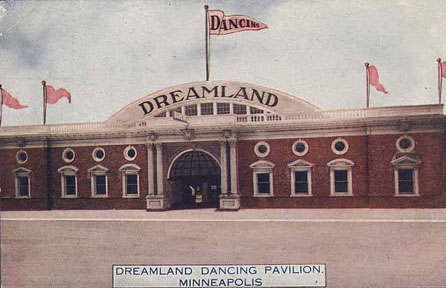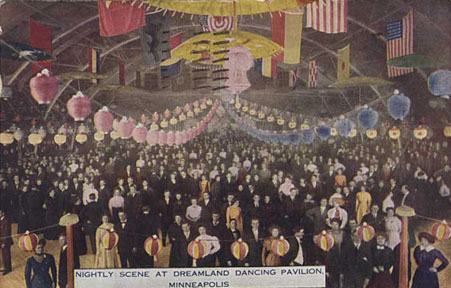Dreamland, Minneapolis
There were two Arcadia Ballrooms: One in Minneapolis, and one in St. Paul. Both were originally called Dreamland.
This one was located at 315 Fifth Street South in Minneapolis, across from the court house.
DREAMLAND
The building was built of brick and steel in 1909 for $30,000 as the Dreamland Dancing Pavilion. The building was 120 ft. by 165 ft. with a 28 ft. ceiling. It had a maple dance floor, with 18,600 square feet available for dancing.

1911 Photo courtesy Minnesota Historical Society
DREAMLAND DANCES
Dreamland was known for its goofy themed dances; some revolved around the usual holidays, but others were the product of someone’s overactive imagination. Most, if not all, involved free giveaways for all. Here are some of them:
- Marathon two-step: men must wear gum boots
- Dance in the Hay, with “Farmyard sports” and giveaways of live chickens and ducks
- Billiken Dance: statuettes of the “God of Happiness” handed out
- Menagerie Dance, with trained elephant, lion, and cock fights?
- Waltz contest on elevated 14″ elevated plank
- Doll and Toy Party
- Post Card Dance
- Foolish Dance, with presents and stunts (April Fool’s Day, 1910)
- Nose Party (no explanation)
- Free Willow Plume (Easter related?)
- Wild West Party
- Motto Dance: All receive “witty and original framed mottoes”
- Novelty Dancing Contest
- Geographical Themes:
- Nights in China, Norway, Ireland, Japan, Germany, Florida
- Coney Island Night: Amusing horse race, novel pillow fight, free redhots
Signs of the times include cock fights and a “Colored Cake Walk” in 1910.
As early as January 1911, and perhaps earlier, the owner was identified as James C. Conway.

1915 Photo courtesy Minnesota Historical Society
Dreamland had problems with admitting underage patrons. Manager Joseph Nathan was found guilty twice in 1911 and 1912, and although he appealed his sentence as unconstitutional, at the last minute his attorney paid his two $100 fines, keeping him out of the workhouse.
In April 1912, W.M. Tobin was the Manager.
In October 1912, Dreamland began offering dance lessons before regular dances.
Dreamland came under new owners from Minneapolis, who instituted new policies: women were admitted for free, and for men, the cost of admission included dancing. This occurred on June 8, 1913.
ARCADIA ROLLER SKATING PALACE
On December 5, 1914, the building was opened for roller skating.
ARCADIA DANCING PALACE
Apparently roller skating wasn’t catching on, and the building reverted back to dancing or a combination of dancing and skating on April 10, 1915.
By the Fall of 1934 it was called the Aragon Ballroom, and remained so until at least New Year’s Eve 1935. The Aragon was more of a venue for the small Minneapolis black community, as evidenced by ads for dances in the Minneapolis Spokesman.
COURT HOUSE GARAGE
From August 1936 to 1945 the building was used as a public storage garage.
HERTZ
In July 1945 the building was purchased by the Hertz Driv-Ur-Self System for $50,000. Hertz used it for storage and servicing its cars. Hertz intended to construct a second story and connect them with ramps, but permit records do not indicate that this was done, and postwar building material restrictions probably made this plan unworkable. The building was purchased from Mrs. Alice Strass/Straus Landers of St. Paul/Pasadena.
The building was demolished in October 1961.
